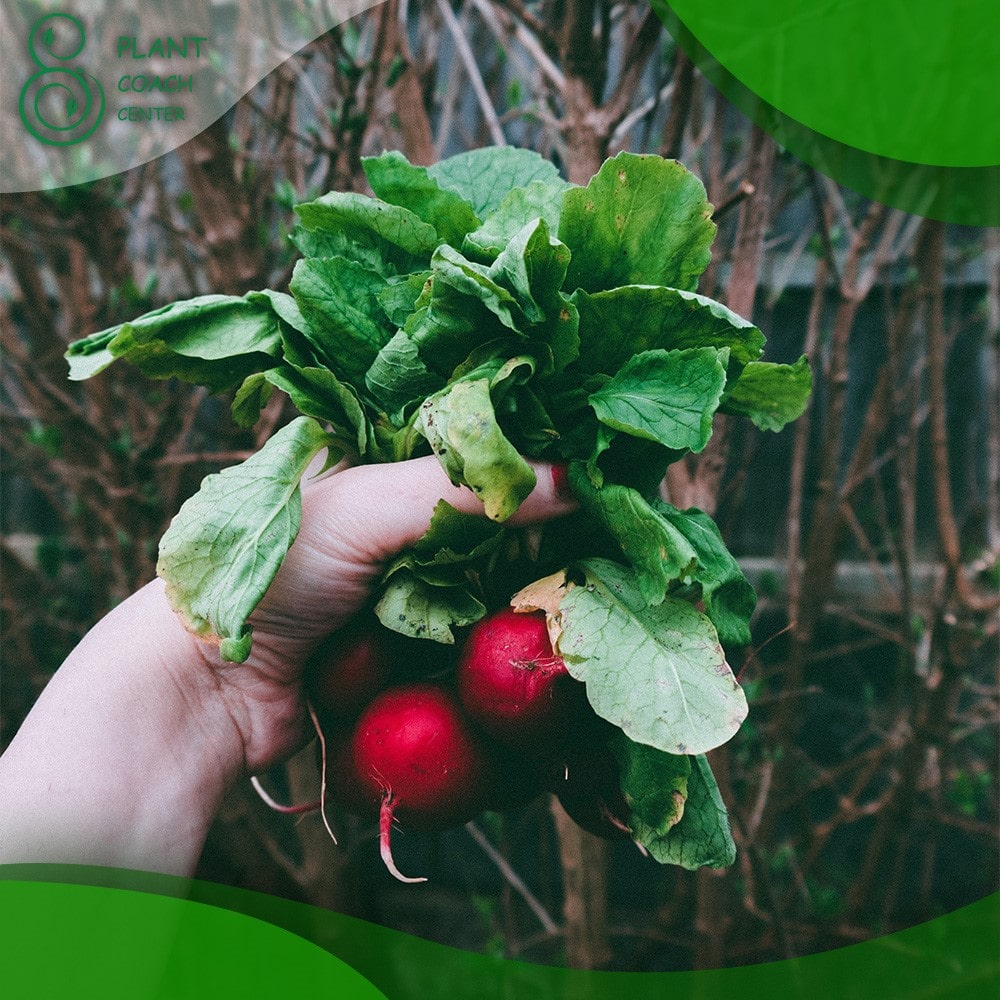When Do You Plant Radishes?
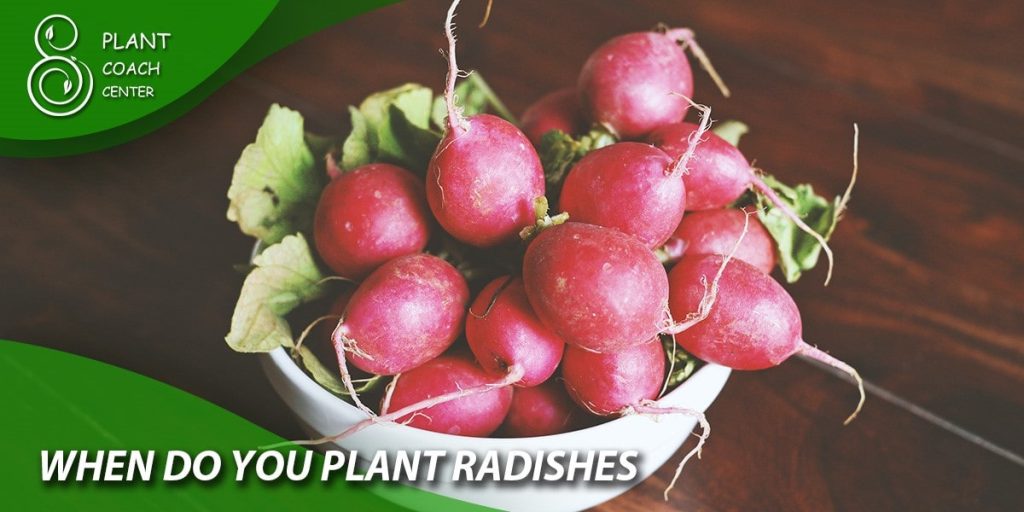
Welcome to the vibrant world of radish cultivation! Whether you’re a seasoned gardener or just beginning your journey into home gardening, the allure of these crisp, colorful root vegetables is undeniable. Radishes, with their quick growth cycle and versatility in the kitchen, have earned a cherished spot in the hearts of plant enthusiasts.
As you embark on this horticultural adventure, it’s essential to grasp the fundamental question: when do you plant radishes? Timing is of the essence, and understanding the intricacies of radish planting seasons can significantly impact your harvest’s success.
In this article, we will delve into the art of radish cultivation, exploring the optimal periods for planting, the various factors that influence growth, and the techniques that can lead to a bountiful radish yield.
Whether you aim to add a zesty crunch to your salads or simply revel in the joy of nurturing new life, join us as we uncover the secrets behind planting radishes at the right time for a rewarding and flavorful gardening experience.
Radishes 101: Understanding the Basics
Radishes, those vibrant and peppery gems of the vegetable world, have captivated gardeners and food enthusiasts for generations. As you embark on your radish-growing journey, it’s crucial to familiarize yourself with the basics of these humble yet delightful root vegetables.
Varieties and Characteristics
Radishes come in a delightful array of varieties, each with unique characteristics and flavors. From the classic round red radishes to elongated daikons and watermelon radishes that surprise with their pink centers, there’s a radish to suit every palate and garden aesthetic.
The common thread among these varieties is their speedy growth – radishes are known for their ability to mature within just a few weeks, making them an ideal choice for both impatient gardeners and those seeking quick rewards.
Soil and Sunlight
Pay close attention to soil quality and sunlight to ensure a successful radish harvest. Radishes thrive in well-draining soil that is rich in organic matter.
Loose and sandy soils encourage proper root development and make harvesting a breeze. When it comes to sunlight, radishes are relatively undemanding. They prefer full sun but can tolerate partial shade, making them suitable for various garden setups.
Sowing Seeds and Spacing
Sowing radish seeds is a straightforward process. Prepare the soil by loosening it to a depth of about 4-6 inches, then plant the seeds about half an inch deep.
Space the bases from 1 to 2 inches apart, depending on the variety. It’s worth noting that radishes are excellent companions for other plants due to their ability to deter certain pests, so consider interplanting them strategically in your garden.
Watering and Care
Consistent moisture is critical to successful radish growth. Keep the soil evenly moist throughout the germination and growth stages. Avoid overwatering, as excessively soggy soil can lead to rot. As the radishes develop, thin them out if they’re too close together, allowing ample room for each root to expand.
Harvesting and Enjoying
One of the most exciting aspects of growing radishes is the harvest – a tangible reward for your efforts. Most radish varieties can be harvested when the roots are around an inch in diameter, but some can grow larger without sacrificing flavor. Gently pull the radishes from the soil, rinse them off, and prepare to enjoy their crisp texture and zesty taste in salads, sandwiches, or as a snack with a sprinkle of salt.
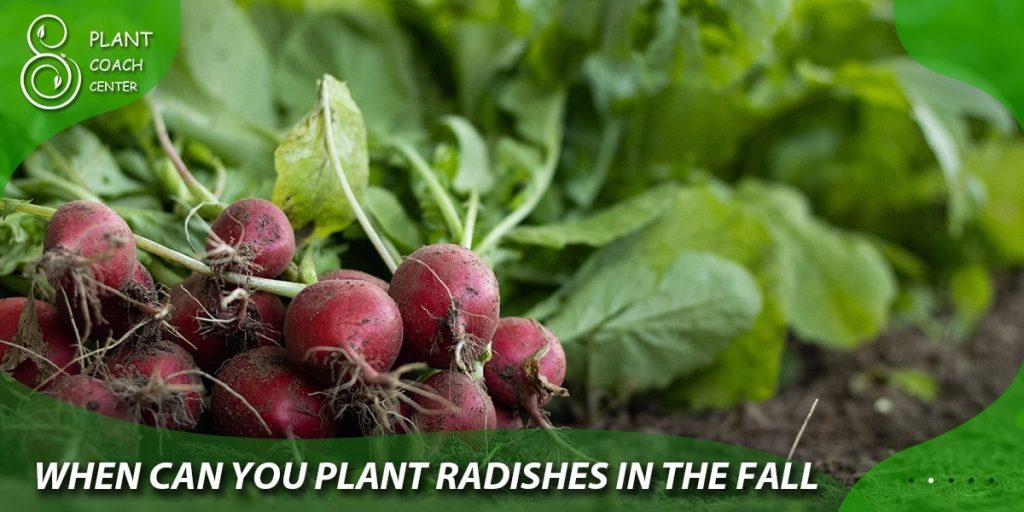
Timing Is Everything: Best Seasons for Radish Planting
When it comes to growing radishes, timing plays a pivotal role in the success of your harvest. These quick-growing root vegetables are well-known for their adaptability to various climates and seasons. However, to make the most of your radish-growing endeavor, aligning your planting schedule with the optimal seasons is essential.
Spring Delights
Spring is the prime time for radish planting in many regions. As temperatures rise and the last frost date passes, the soil starts to warm up, creating the perfect conditions for radish seeds to germinate. Depending on your location, you can begin to sow radish seeds as early as late winter in milder climates or in early spring for colder regions. The cool spring temperatures prevent the radishes from becoming too pungent or developing a woody texture.
Fall Magic
Fall planting offers another opportunity to enjoy a bountiful radish harvest. As the summer heat wanes and the days become shorter, radishes thrive in the milder conditions.
Fall-planted radishes often have a milder flavor than their spring counterparts, making them an excellent choice for salads and snacking. Aim to sow radish seeds about 4 to 6 weeks before the first expected frost date, giving them ample time to mature before winter.
Avoiding the Summer Slump
While radishes are adaptable, they tend to struggle during the intense heat of summer. If you live in a region with scorching summers, consider planting radishes in a spot that receives partial shade or providing shade cloth to protect them from the harsh sun. Alternatively, you can focus on spring and fall planting to avoid the challenges of summer temperatures.
Indoor Options
If you want to enjoy radishes year-round, consider starting some seeds indoors. This approach allows you to control the growing environment and extend the radish-growing season beyond the limits of your local climate. Once the seedlings are established, you can transplant them outdoors when favorable conditions give you a head start on your outdoor planting.
Sowing Seeds or Seedlings: Which One Win?
The decision between sowing radish seeds directly into the ground or starting with seedlings can significantly impact the success of your radish cultivation. Each approach has advantages and considerations, catering to different gardening preferences and goals.
Starting from Seeds
Sowing radish seeds directly into the soil is the classic approach and offers a sense of satisfaction as you witness the entire growth journey from germination to harvest. This method is simple and cost-effective, requiring minimal equipment. It’s particularly suited for gardeners who want a direct connection to the natural rhythms of plant growth.
However, direct sowing demands attention to soil preparation, moisture consistency, and thinning as the seedlings emerge. You’ll need extra care to protect the seeds from pests and unfavorable weather conditions during germination. Direct sowing can yield robust radishes with well-established root systems if done correctly.
Opting for Seedlings
Starting radish seeds indoors and transplanting the seedlings into the garden provides several advantages. Seedlings are less susceptible to pests and environmental stressors during their delicate early stages, which can lead to higher germination rates. This method also allows you to control the growing conditions, ensuring the seedlings have a strong start.
Transplanting radish seedlings can extend the growing season, as you can begin growing them indoors before the last frost or continue cultivating them indoors as colder weather approaches. Remember that transplanting can be tricky; radish seedlings have delicate roots that can be disrupted during the process. Be sure to transplant them carefully and provide them with appropriate post-transplant care.
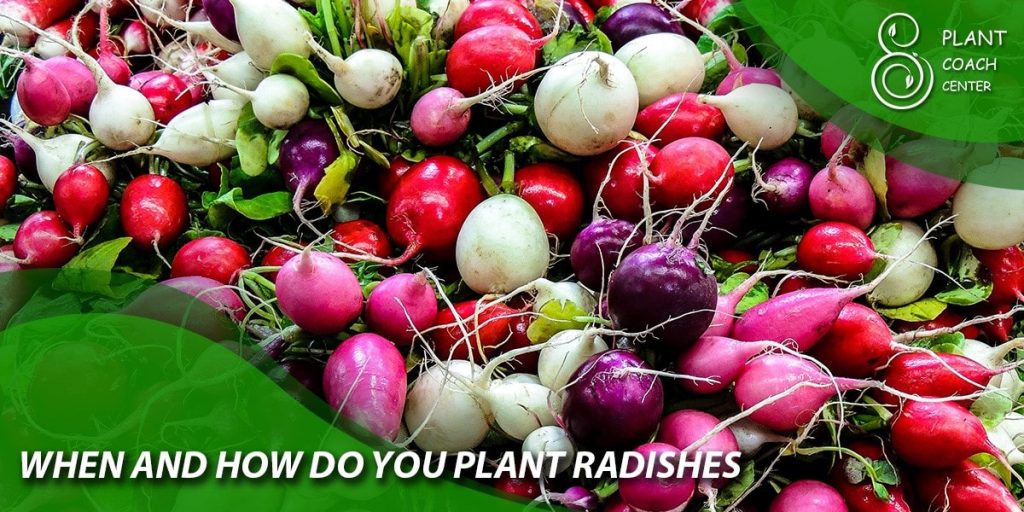
Finding the Right Fit
The choice between sowing seeds or seedlings ultimately depends on your gardening style, climate, and available resources. If you’re a beginner, direct sowing might be a great way to learn about the natural growth cycle of radishes. If you’re dealing with a short growing season or challenging weather, starting with seedlings could give your radishes a head start.
In conclusion, there’s no one-size-fits-all answer to whether seeds or seedlings are better. Both methods have their merits and challenges. Whichever route you choose, remember that patience, care, and a touch of experimentation will guide you toward a successful and satisfying radish-growing experience.
Nurturing Radishes Indoors and Outdoors
Radishes, those quick-growing and vibrant root vegetables, can thrive indoors and outdoors with a bit of attention to their unique needs. Whether you have a spacious garden or limited outdoor space or an apartment dweller with only indoor space, you can still enjoy the satisfying process of nurturing these crunchy delights.
Outdoor Care
Radishes are relatively undemanding for those fortunate enough to have outdoor garden space. Choose a sunny spot for your radish bed, as they prefer full sun but can tolerate some light shade. Prepare the soil by ensuring it’s well-draining, loose, and enriched with organic matter. This will help radishes develop robust root systems and minimize the risk of rot.
Maintain consistent moisture in the soil throughout the growing period. Be cautious not to overwater, as soggy soil can lead to issues. Applying a layer of mulch around your radishes can help retain moisture and regulate soil temperature. Regularly inspect your plants for signs of pests or diseases, and take appropriate action if any issues arise.
Indoor Cultivation
Growing radishes indoors is an excellent option for those with limited outdoor space or those looking to extend their growing season. You’ll need containers with good drainage and a well-balanced potting mix. Choose a sunny windowsill or provide supplemental light with grow lights to ensure your indoor radishes receive sufficient sunlight.
When growing radishes indoors, consider starting with fast-maturing varieties to maximize space and yield. Adequate air circulation is essential to prevent mold or fungal issues, so avoid overcrowding your containers. Keep the soil consistently moist but not waterlogged. Depending on the indoor humidity levels, you may need to adjust the watering frequency.
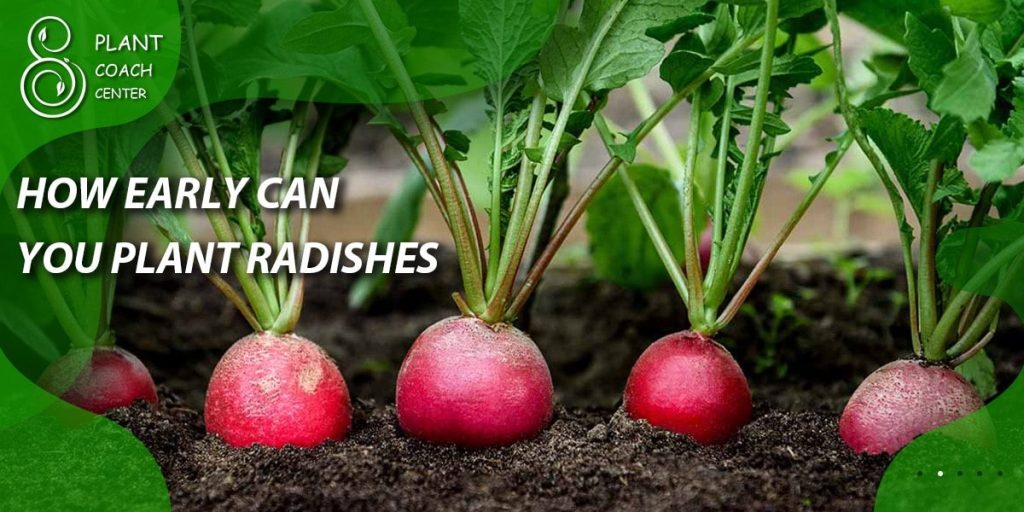
Common Core Consideration
Regular and moderate watering is critical whether you’re nurturing radishes indoors or out key. Radishes are shallow-rooted, so they’re sensitive to drought and excessive moisture.
Thin-out seedlings give them ample room to grow; this reduces competition for nutrients and sunlight. Fertilize sparingly with a balanced fertilizer, as excessive nitrogen can lead to lush foliage and underdeveloped roots.
Watch out for signs of stress, pests, or diseases in indoor and outdoor scenarios. Early intervention is essential to prevent any issues from spiraling out of control. As your radishes develop, you’ll notice the telltale signs of readiness for harvest, such as the visible bulb poking out of the soil. A gentle tug will confirm whether they’re ready to be enjoyed.
Companion Planting: Radishes’ Garden Partners
In the intricate dance of gardening, companion planting emerges as a strategy that not only fosters harmony but also boosts your garden’s overall health and productivity. With their unique properties, radishes play a starring role in this horticultural choreography, often serving as exceptional partners to various plants.
Radishes as Guardians
One of the remarkable qualities of radishes is their ability to repel certain pests and deter unwanted garden visitors. Planting radishes alongside susceptible crops like cucumbers, zucchini, and squash can help fend off pests like cucumber beetles and bugs. Their natural compounds and pungent scent are a deterrent, creating a protective barrier for neighboring plants.
Radishes and Leafy Greens
Leafy greens, such as lettuce and spinach, thrive in the company of radishes. Radishes’ quick growth helps shade the soil around them, keeping it more relaxed and more moisture-retentive. This shade can benefit delicate greens that might bolt or wilt in the heat. Plus, radishes’ deep roots help break up compacted soil, improving water and nutrient absorption for both plants.
Carrots and Radishes
The classic pairing of carrots and radishes is not just a culinary match made in heaven but a horticultural win. Carrots can be slow to germinate and establish their presence, leaving the soil vulnerable to weeds.
By interplanting them with radishes, you encourage quick germination and growth of the radishes, which helps break up the ground, making it easier for the carrots to push through. As radishes are harvested, they create space for the carrots to expand.
Strategic Planting for Space Utilization
Radishes’ rapid growth makes them ideal for maximizing your garden’s productivity. Consider sowing radishes between slower-growing plants that need extra time to mature, like tomatoes or peppers. By the time the larger plants spread their branches, the radishes will have been harvested, freeing up space without compromising the overall yield.
Cautions and Considerations
While companion planting with radishes offers numerous benefits, you must be aware of potential interactions that might not work in your favor. Avoid planting radishes near beans, as the two can hinder each other’s growth due to differences in their nutrient needs. Not all herbs and flowers are radish-friendly, so research and experimentation are crucial to finding the best companions for your specific garden setup.
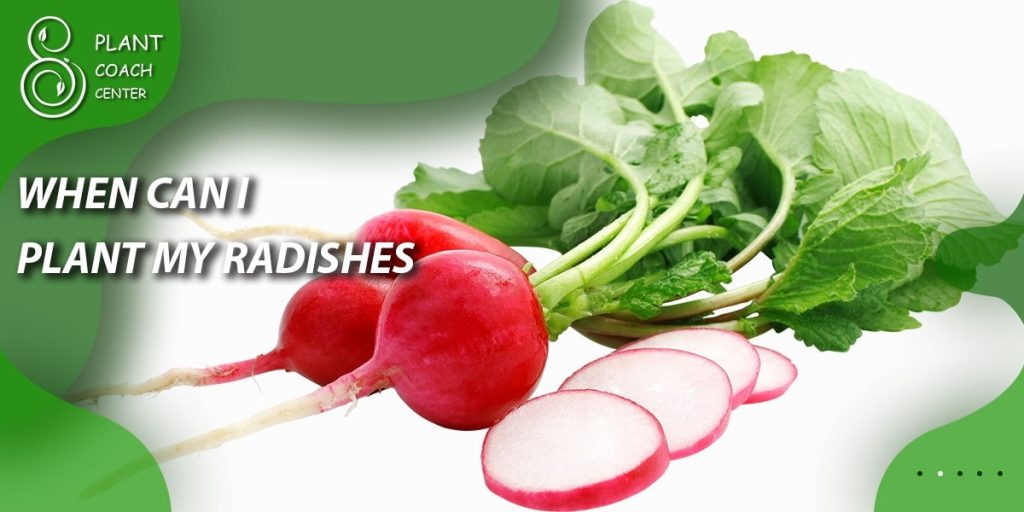
Troubleshooting Growth Issues and Harvesting Clues
While radishes are generally easy to grow, encountering a few bumps along the gardening path is not uncommon. Recognizing and addressing growth issues promptly can make a significant difference in the quality of your radish harvest. Additionally, knowing the subtle signs that indicate when your radishes are ready for picking can elevate your gardening experience to new heights.
Common Growth Challenges
Stunted Growth: If your radishes fail to thrive and appear small, the culprit might be overcrowding. Radishes need adequate space to develop their roots, so thinning them out if they’re too close together is crucial.
Sparse Foliage: Weak or light foliage might signal a lack of nutrients in the soil. Ensure your soil is well-draining and amend it with compost or a balanced fertilizer to provide the necessary nutrients.
Cracking: Radishes can crack when they experience inconsistent watering. Aim for even moisture to prevent rapid fluctuations in growth conditions.
Pests and Diseases: Look for pests like aphids, flea beetles, or cabbage maggots. Also, watch for fungal diseases like powdery mildew. Regular inspections and appropriate treatments can help mitigate these issues.
Harvesting Clues
Bulb Size: The size of the radish bulb varies depending on the variety. However, a good rule of thumb is to harvest when the bulb is of a suitable size for that variety. You can gently pull one out to check its size without harming the rest.
Visible Bulb: As radishes mature, the bulb becomes more visible above the soil line. This is a clear sign that they are ready for harvesting. Don’t let them stay in the ground for too long after this point, as they might become woody or develop a pungent taste.
Consistent Color: The color of the upper portion of the radish should be compatible with its variety. For instance, if you’re growing red radishes, they should have a vibrant red hue. They might only be fully mature if the color is light and consistent.
Harvesting Techniques
To harvest your radishes, gently grip the greens near the soil line and pull upwards steadily. If the gardens don’t come off quickly, you can use a small trowel to loosen the soil around the radish before pulling. Be careful not to yank too forcefully, as radishes can break off if you’re too aggressive.
Conclusion
As you embark on your radish-growing journey, armed with insights into optimal planting seasons, companion planting strategies, troubleshooting techniques, and timing your harvest, you’re equipped with the knowledge to cultivate a thriving radish garden. Whether you’re nurturing them indoors or in your outdoor sanctuary, the vibrancy of radishes and their versatility in the kitchen promise a rewarding experience.
Remember, radishes are about satisfying your taste buds and connecting with the rhythms of nature and the joys of cultivation. By integrating the wisdom shared here, you’ll be well-prepared to nurture your radishes from tiny seeds to robust roots.
For more gardening inspiration, tips, and resources, remember to visit PlantCouchCenter.com. So, roll up your sleeves, get your hands in the soil, and let the journey of growing radishes be a source of both nourishment and delight in your green haven.
Can I grow radishes year-round?
Radishes thrive in cooler temperatures of spring and fall, but indoor planting can extend the growing season.
What's the best spacing for radish seeds?
Space radish seeds about 1-2 inches apart for optimal growth and development.
How do I know when radishes are ready to harvest?
Harvest radishes when their bulbs visibly protrude from the soil, reaching the desired size.


